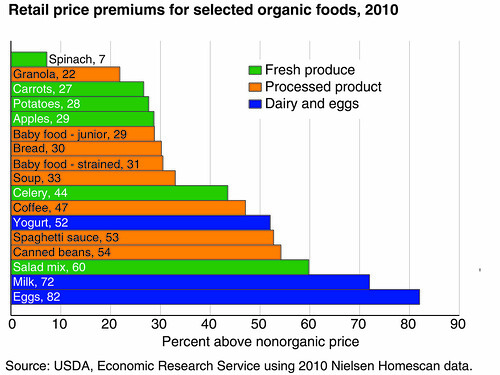
This post is part of the Science Tuesday feature series on the USDA blog. Check back each week as we showcase stories and news from USDA’s rich science and research portfolio.
Consumer demand for organically produced goods has shown double-digit growth during most years since the 1990s, according to industry statistics, providing market incentives for U.S. farmers across a broad range of products. Consumers can now purchase organic food at nearly three out of four conventional grocery stores. These products generally carry a price that reflects the additional costs of producing organic foods and of keeping products segregated throughout the supply chain. The price premiums reflect these costs as well as consumers’ willingness to pay more for organic products.
A new Economic Research Service report provides estimated retail price premiums—and changes in premiums—for 17 commonly purchased organic foods relative to their nonorganic counterparts from 2004 to 2010. We used grocery store purchase data from a large set of nationally representative households. The data included detailed information on each product (degree of processing, flavor, package size, and whether organic), its price, and where it was purchased, allowing us to isolate the organic price premium.
Our analysis, unique in number of years and products examined, found that organic price premiums in 2010 were more than 20 percent of the nonorganic price for all but 1 (fresh spinach) of the 17 products. Milk and eggs had the highest premiums—72 percent of the nonorganic price for milk and 82 percent for eggs. Organic eggs and dairy products have high production costs since chickens and cows must be given organic feed, have access to the outside, and be free of hormones and antibiotics. Demand for organic foods fed to children, such as milk and baby food, may also play a role in the price premium level. Among organic fresh fruits and vegetables, premiums in 2010 ranged from just 7 percent for fresh spinach to 60 percent for salad mix. For organic processed foods that year, price premiums ranged from 22 percent for granola to 54 percent for canned beans.
Most organic price premiums fluctuated over the 7-year study period. Premiums for organic baby food ranged from 18 to 53 percent above the nonorganic price, while premiums for apples were between 29 and 44 percent. Organic eggs displayed the largest fluctuations in price premiums—between 66 and 173 percent.
More information on organic price premiums—and on the growth in sales of organic products—is in our report, Changes in Retail Organic Price Premiums from 2004 to 2010.
